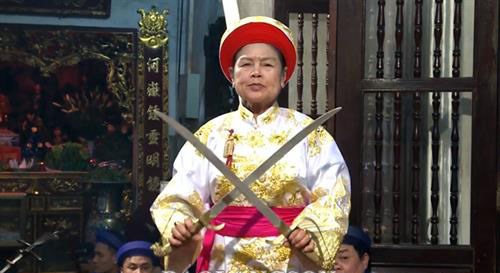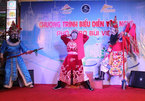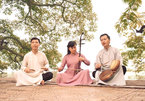 |
|
Artisan Ta Thi Bich Loc performs chầu văn during a festival at Cua Dong Temple in the northern mountainous province of Lang Son. (Photo baolangson.vn)
|
Loc, now 80, works at Cua Dong Temple in LangSon city in the northern province of Lang Son. She has vowed to devote herlife to the preservation of this traditional ritual, and she has beena ’chau van’ singer for more than 40 years.
The artisan said she first heard ’chau van’ when shewas six years old when her mother took her to a local festival.
“When I was a little girl, I enjoyed goingwith my mother to temples and pagodas and watching haudong (also known len dong) trance shows. The charming folk musicof ’chau van’ was part of the performances and affected meso much I vowed to become a singer,” Loc said.
“Every time I listened to the chanting, Iwondered how the singers could remember the lyrics and melodies.They are beautiful but very hard to sing,” according to Loc.
‘Chau van’ or ‘hat van’, alsoknown as ‘hat bong’, is a popular singing ritual in Vietnamesespiritual culture, and started in the north of the country.
It appears in the Vietnamese beliefs of theMother Goddesses of Three – Four Realms, which often accompanies ‘hau dong’ orspiritual rituals in pagodas and temples to honour the Mother Goddessesand form a connection between people and the Gods.
‘Hau dong’ involves singing and dancingby psychics to express the will and instructions of supernatural beings.
The ancient lyrics of ’chau van’ songswere designed to sound poetic and invite Gods or divinities to descendto Earth.
‘Chau van’ singers are often elderlyartisans who can play instruments and take turns singing for up to eight hours.
The dan nguyet (moon-shaped lute) isnormally the main instrument used for a ’chau van’ performance, alongwith phach (a piece of wood or bamboo to mark the rhythm), senh (clappers), trongban (drums), chieng (small gongs), dantranh (16-stringed zither) and sao (flute).
Experts said instruments play a veryimportant role in ’chau van’ as they could both emphasise importantpassages and create contrasting effects to the lyrics.
Loc was first taught ’chau van’ in1978 by Nguyen Thi Tỵ, who also worked at Ky Cung Temple in Vinh Trai ward, LongSon city. Ty, who is also a ’chau van’ singer taught the art in Chi Langward.
After successfully mastering theprinciples, techniques and content of the songs, Loc has regularlyparticipated in rituals dedicated to the Mother Goddesses since 1990.
In 1995, with the permission of localauthorities, Loc and her family launched a programme to call for donations toinvest in restoring and preserving Cua Dong Temple.
Thanks to the successful programme, the templereceived a certification recognising it as a provincial relic in 2002, and itwas recognised as a national relic in 2015.
Loc has performed at temples throughout Lang Sonand other provinces and cities.
She has also participated in festivals overseas,including the Vietnam–Republic of Korea Culture Exchange Festival inSeoul.
With her passion for singing and deep love forfolk music, Loc is always thinking about how to pass on her skills and lovefor ’chau van’ to future generations.
Loc has helped 116 people learn about ’chauvan’ performances.
”I want to transfer everything I knowabout ’chau van’ to the students so I always encourage them to tryand preserve the art. I tell them that to study and sing ’chauvan’, they should be passionate and determined,” Loc said.
Nguyen Hai Thanh, an incense lighter at CoBe Thuong Ngan (Little Girl Goddess of the Forest) Temple in Lang Son city, isone those students, and has been praised by Loc as a pioneer in preservingand promoting the folk art.
“I was really lucky to become one of herfollowers. She taught me from the most simple sentences and tried torefine my work to the upper levels of ancient rituals,” Thanh said.
Chairman of the Lang Son Cultural HeritageAssociation Hoang Van Pao said ’chau van’ was an indispensableactivity of Mother Goddesses in Lang Son, and Loc was one of the mostexperienced singers who had grasped the ancient and precious skills and rulesof the ritual.
“Loc has an open heart and is dedicatedto ’chau van’, which is a precious traditional ritual,” Paosaid./.VNA/VNS

Traditional theatres hunt for new talent
Traditional art theatres in HCM City are facing a shortage of artists and musicians, which has made it tough for the members of each theatre to keep up with their performance schedules.

Composer combines two traditional art types in music video
Composer Nguyen Quang Long has released a new music video combining the traditional arts of xẩm (blind busketers’ singing) and quan họ (love duets).
 The beautiful melody of traditional instruments and the charming lyrics of chau van (trance ritual singing) have enchanted Ta Thi Bich Loc since she was a small child." itemprop="description" />
The beautiful melody of traditional instruments and the charming lyrics of chau van (trance ritual singing) have enchanted Ta Thi Bich Loc since she was a small child." itemprop="description" />